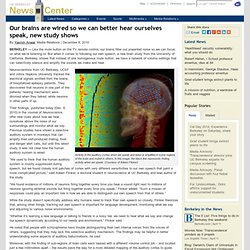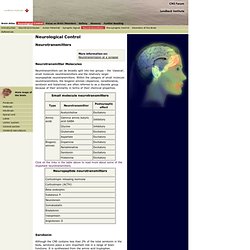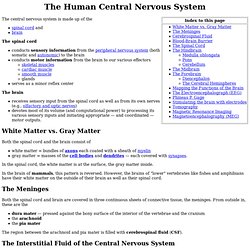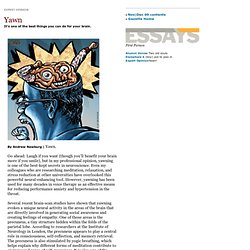

Our Brains and Hearing. Like the mute button on the TV remote control, our brains filter out unwanted noise so we can focus on what we’re listening to.

But when it comes to following our own speech, a new brain study from the University of California, Berkeley, shows that instead of one homogenous mute button, we have a network of volume settings that can selectively silence and amplify the sounds we make and hear. Activity in the auditory cortex when we speak and listen is amplified in some regions of the brain and muted in others. In this image, the black line represents muting activity when we speak. (Courtesy of Adeen Flinker) Neuroscientists from UC Berkeley, UCSF and Johns Hopkins University tracked the electrical signals emitted from the brains of hospitalized epilepsy patients. Their findings, published today (Dec. 8, 2010) in the Journal of Neuroscience, offer new clues about how we hear ourselves above the noise of our surroundings and monitor what we say. Neurological Control - Neurotransmitters.
Neurotransmitter Molecules Neurotransmitters can be broadly split into two groups – the ‘classical’, small molecule neurotransmitters and the relatively larger neuropeptide neurotransmitters.

Within the category of small molecule neurotransmitters, the biogenic amines (dopamine, noradrenaline, serotonin and histamine) are often referred to as a discrete group because of their similarity in terms of their chemical properties. Click on the links in the table above to read more about some of the important neurotransmitters. Serotonin Although the CNS contains less than 2% of the total serotonin in the body, serotonin plays a very important role in a range of brain functions. Within the brain, serotonin is localised mainly in nerve pathways emerging from the raphe nuclei, a group of nuclei at the centre of the reticular formation in the Midbrain, pons and medulla.
Noradrenaline Find out more about noradrenaline and serotonin Dopamine Acetylcholine Neurotransmitter Receptors Serotoning receptors. Brain Exercise. UCLA scientists have found that for computer-savvy middle-aged and older adults, searching the Internet triggers key centers in the brain that control decision-making and complex reasoning.

The findings demonstrate that Web search activity may help stimulate and possibly improve brain function. The study, the first of its kind to assess the impact of Internet searching on brain performance, is currently in press at the American Journal of Geriatric Psychiatry and will appear in an upcoming issue. Additional details on the study and further research on the impact of computer technologies on the aging brain are highlighted in Small's new book, "iBrain: Surviving the Technological Alteration of the Modern Mind". Dr. Gary Small, a professor at the Semel Institute for Neuroscience and Human Behavior at UCLA who holds UCLA's Parlow-Solomon Chair on Aging. says: "Internet searching engages complicated brain activity, which may help exercise and improve brain function". The Central Nervous System. The central nervous system is made up of the The spinal cord conducts sensory information from the peripheral nervous system (both somatic and autonomic) to the brain conducts motor information from the brain to our various effectors serves as a minor reflex center The brain receives sensory input from the spinal cord as well as from its own nerves (e.g., olfactory and optic nerves) devotes most of its volume (and computational power) to processing its various sensory inputs and initiating appropriate — and coordinated — motor outputs.

White Matter vs. Yawning and the Brain. By Andrew Newburg | Yawn.

Go ahead: Laugh if you want (though you’ll benefit your brain more if you smile), but in my professional opinion, yawning is one of the best-kept secrets in neuroscience. Even my colleagues who are researching meditation, relaxation, and stress reduction at other universities have overlooked this powerful neural-enhancing tool. However, yawning has been used for many decades in voice therapy as an effective means for reducing performance anxiety and hypertension in the throat. Several recent brain-scan studies have shown that yawning evokes a unique neural activity in the areas of the brain that are directly involved in generating social awareness and creating feelings of empathy.
One of those areas is the precuneus, a tiny structure hidden within the folds of the parietal lobe. Why am I so insistent? As a young medical student, I was once “caught” yawning and actually scolded by my professor. My advice is simple.